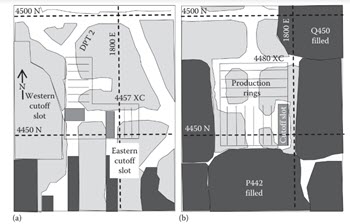Detailed stope design relates to the extraction of individual stopes within a stoping block or global area. Detailed design is the process of establishing an optimum extraction method for an individual stope, subject to a number of variables and constraints. Blasthole geometry, firing sequence, ground support, ventilation, and economics are some of the key variables considered. The constraints include the orebody boundaries, the geological structures, any existing development and, in some cases, any adjacent fill masses. Figure 3.47 shows a typical process for taking an open stope from conceptual design through to production at the then WMC Resources, Australia (Teasdale, 2001). The detailed design process begins when the geological team undertakes detailed orebody delineation for a particular stope extraction.

In-fill delineation drilling, mapping, sampling, and geological interpretations on a stope scale are then completed. The mine planning engineer uses geological sections from a mine design package to do a preliminary stope design, while the rock mechanics engineer completes a rock mass characterization program, providing guidelines for stope stability, dilution control, reinforcement, and blast sequencing.
At this stage, extraction factors that account for dilution as well as back analysis of performance from any adjacent stopes are taken into account. Drill and blast design is undertaken considering the equipment capabilities to ensure that the designed stope shape is achievable. This is then followed
by an economic analysis that determines stope viability by considering the break-even revenue cutoff figures including a calculation of net revenue versus total mining, concentrating, and overhead cost. Finally, a stope design document that includes detail of the overall extraction philosophy, plans of sublevel development, sections showing blasthole design concepts and drilling and blasting parameters, ore- and waste-handling systems, ventilation, geology, rock mechanics, and overall firing sequence is issued to the operating personnel.
All the topics included in a stope design document are interrelated. The extraction philosophy provides a general overview of the design, safety, and production issues for a particular section of an orebody. Properly reinforced stope development is required to allow access for drilling, blasting, and mucking. Development size is a function of the stoping method and the equipment utilized. Development allows for the drill geometries to be designed, as well as subsequent ring firers’ access to charge the rings. Knowledge of the nature and stability of the adjacent fill masses is needed to design cleaner rings or to avoid toeing of blastholes into the fill.
Geological considerations such as the presence of major geological discontinuities often influence the blasting sequences. Other factors considered are the stress redistributions within and around a stope that are likely to control falloff behavior on the exposed walls. In addition, the retreat direction of the blasthole rings must take into account the stope ventilation network, with a retreat direction into fresh air. Progress through a detailed design process can be tracked using a stope control sheet that can be used to track progress with preliminary design, production, and filled stopes.
Geological Information
The typical geological information required for stope design consists of grade and tonnage, dilution factors, and delineation of the main geological features intersecting a stoping area. The initial information is usually collected from the diamond drillholes intersecting the area of interest. This information is used to create a conceptual three-dimensional orebody delineation design with ore tonnages and grades. Empirical extraction and dilution factors that account for the expected tonnage and dilution are issued prior to the preliminary economic analysis. A 110/96 factor indicates that up to 10% additional tonnes are expected from the stope. In addition, a 4% reduction on the grade is also expected.



0 Comments